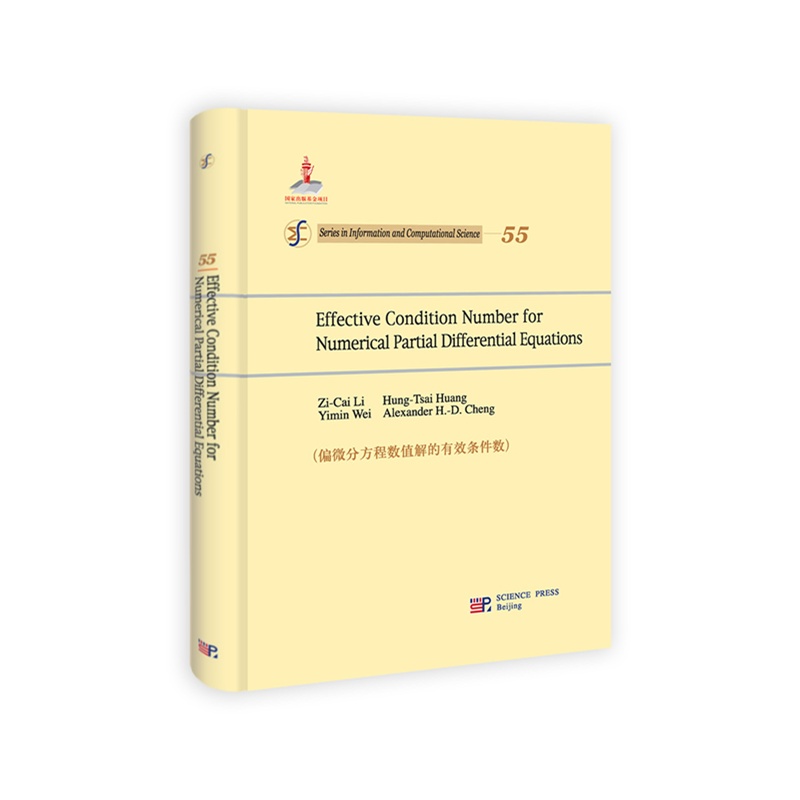 [内容简介]
[内容简介]
本书主要介绍偏微分方程数值解的有效条件数。首先介绍有效条件数的概念,与经典条件数概念的差异,接着将有效条件数运用于TREFFTZ方法;我们还讨论了有限差分和有限元方法的有效条件数,最后研究了截断奇异值分解和TIKHONOV正则化的有效条件数。
[目录]
Preface
Acknowledgments
Chapter 1 Effective Condition Number
1.1 Introduction
1.2 Preliminary
1.3 Symmetric Matrices
1.3.1 Deffnitions of Effective condition numbers
1.3.2 A posteriori computation
1.4 Overdetermined Systems
1.4.1 Basic algorithms
1.4.2 Reffnements of (1.4.10)
1.4.3 Criteria
1.4.4 Advanced reffnements
1.4.5 Effective condition number in p-norms
1.5 Linear Algebraic Equations by GE or QR
1.6 Application to Numerical PDE
1.7 Application to Boundary Integral Equations
1.8 Weighted Linear Least Squares Problems
1.8.1 Effective condition number
1.8.2 Perturbation bounds
1.8.3 Applications and comparisons
Chapter 2 Collocation Trefftz Methods
2.1 Introduction
2.2 CTM for Motz's Problem
2.3 Bounds of Effective Condition Number
2.4 Stability for CTM of Rp=1
2.5 Numerical Experiments
2.5.1 Choice of Rp
2.5.2 Extreme accuracy of D0
2.6 GCTM Using Piecewise Particular Solutions
2.7 Stability Analysis of GCTM
2.7.1 Trefftz methods
2.7.2 Collocation Trefftz methods
2.8 Method of Fundamental Solutions
2.9 Collocation Methods Using RBF
2.10 Comparisons Between Cond_eff and Cond
2.10.1 CTM using particular solutions for Motz's problem
2.10.2 MFS and CM-RBF
2.11 A Few Remarks
Chapter 3 Simpliffed Hybrid Trefftz Methods
3.1 The Simpliffed Hybrid TM
3.1.1 Algorithms
3.1.2 Error analysis
3.1.3 Integration approximation
3.2 Stability Analysis for Simpliffed Hybrid TM
Chapter 4 Penalty Trefftz Method Coupled with FEM
4.1 Introduction
4.2 Combinations of TM and Adini0s Elements
4.2.1 Algorithms
4.2.2 Basic theorem
4.2.3 Global superconvergence
4.3 Bounds of Cond_eff for Motz's Problem
4.4 Effective Condition Number of One and Inffnity Norms
4.5 Concluding Remarks
Chapter 5 Trefftz Methods for Biharmonic Equations with Crack Singularities
5.1 Introduction
5.2 Collocation Trefftz Methods
5.2.1 Three crack models
5.2.2 Description of the method
5.2.3 Error bounds
5.3 Stability Analysis
5.3.1 Upper bound for σmax(F)
5.3.2 Lower bound for σmin(F)
5.3.3 Upper bound for Cond_eff and Cond
5.4 Proofs of Important Results Used in Section 5.3
5.4.1 Basic theorem
5.4.2 Proof of Lemma 5.4.3
5.4.3 Proof of Lemma 5.4.4
5.5 Numerical Experiments
5.6 Concluding Remarks
Chapter 6 Finite Difference Method
6.1 Introduction
6.2 Shortley-Weller Difference Approximation
6.2.1 A Lemma
6.2.2 Bounds for Cond EE
6.2.3 Bounds for Cond_eff
Chapter 7 Boundary Penalty Techniques of FDM
7.1 Introduction
7.2 Finite Difference Method
7.2.1 Shortley-Weller Difference approximation
7.2.2 Superconvergence of solution derivatives
7.2.3 Bounds for Cond_eff
7.3 Penalty-Integral Techniques
7.4 Penalty-Collocation Techniques
7.5 Relations Between Penalty-Integral and Penalty-Collocation Techniques
7.6 Concluding Remarks
Chapter 8 Boundary Singularly Problems by FDM
8.1 Introduction
8.2 Finite Difference Method
8.3 Local Reffnements of Difference Grids
8.3.1 Basic results
8.3.2 Nonhomogeneous Dirichlet and Neumann boundary conditions
8.3.3 A remark
8.3.4 A view on assumptions A1-A4
8.3.5 Discussions and comparisons
8.4 Numerical Experiments
8.5 Concluding Remarks
Chapter 9 Finite Element Method Using Local Mesh Refinements
9.1 Introduction
9.2 Optimal Convergence Rates
9.3 Homogeneous Boundary Conditions
9.4 Nonhomogeneous Boundary Conditions
9.5 Intrinsic View of Assumption A2 and Improvements of Theorem 9.4.1
9.5.1 Intrinsic view of assumption A2
9.5.2 Improvements of Theorem 9.4.1
9.6 Numerical Experiments
Chapter 10 Hermite FEM for Biharmonic Equations
10.1 Introduction
10.2 Description of Numerical Methods
10.3 Stability Analysis
10.3.1 Bounds of Cond
10.3.2 Bounds of Cond_eff
10.4 Numerical Experiments
Chapter 11 Truncated SVD and Tikhonov Regularization
11.1 Introduction
11.2 Algorithms of Regularization
11.3 New Estimates of Cond and Cond_eff
11.4 Brief Error Analysis
Appendix Deffnitions and Formulas
A.1 Square Systems
A.1.1 Symmetric and positive deffnite matrices
A.1.2 Symmetric and nonsingular matrices
A.1.3 Nonsingular matrices
A.2 Overdetermined Systems
A.3 Underdetermined Systems
A.4 Method of Fundamental Solutions
A.5 Regularization
A.5.1 Truncated singular value decomposition
A.5.2 Tikhonov regularization
A.6 p-Norms
A.7 Conclusions
Epilogue
Bibliography
Index

 新书报道
新书报道